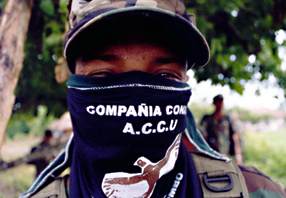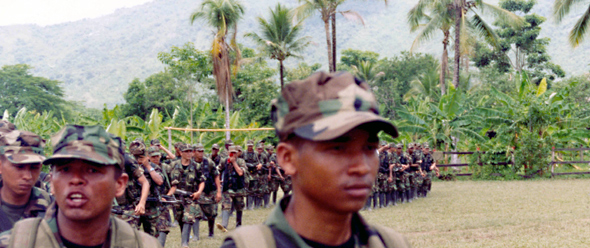by Mary Roldán
September 16, 2004
In a 2004 television ad campaign intended to raise people’s awareness about the plight of two million Colombian citizens, black-and-white images of displaced people float like ghosts. A homeless mother asks an impassive, oblivious female driver for money, while business-suit-clad pedestrians barrel briskly along crowded city streets, indifferent to the pleas of these desperate wanderers, selling fruit, chewing gum, or cheap gewgaws. “Somos desplazados” (we are displaced) read the crude cardboard signs that bear silent witness to this humanitarian tragedy.

These people — some five percent of Colombia’s 42 million people — make up the largest internally displaced population in the Western hemisphere, and the largest in the world in a country not officially at war. Many of the displaced are Afro-Colombians or people of indigenous descent, others simply farmers or small-town residents — the majority women and children — who had made their homes in areas marked by continuing struggles over land, resources and labor, where the government has historically exercised little control.
While rural Colombians have long suffered the consequences of an inequitable distribution of land and wealth — at mid-century, half of Colombia’s land was owned by three percent of its population — the current situation has its roots in the period of extended civil conflict known simply as “La Violencia” (the violence), that grew out of a struggle for power between the country’s Liberal and Conservative Parties in the 1940s and 1950s. Two hundred thousand Colombians died, more than a million lost their properties, and nearly two million were forced to migrate during the ensuing violence. La Violencia eventually came to encompass both criminal banditry and socially motivated peasant mobilizations, and in some cases, provided the nucleus for the emergence of armed guerrilla groups such as the FARC.

With the rise of the cocaine trade in the 1970s, newly minted narco-millionaires invested illicitly obtained profits in massive land purchases, often in the very areas where longstanding conflicts between guerrillas, ranchers, and multinational companies were concentrated, further destabilizing the lives of Colombia’s peasants. To protect their assets from guerrilla extortion, traffickers recruited, armed and paid private security forces, many of whom evolved into paramilitary operatives. Rural inhabitants in particularly contested parts of the Colombian countryside became the unwitting obstacles — or reluctant participants — in the expanding territorial struggle between insurgent groups and government forces.

